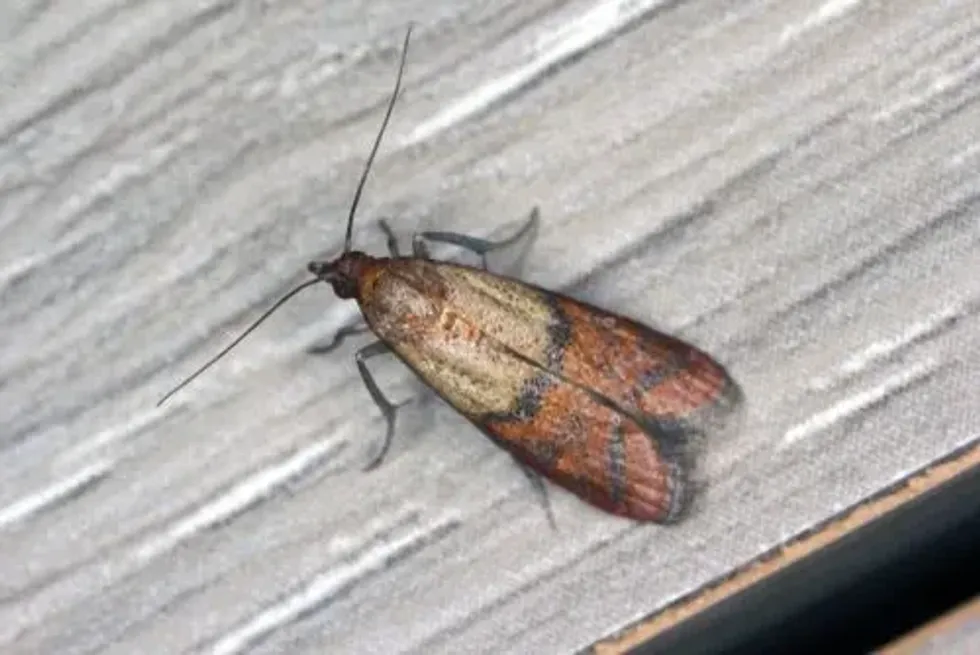The Indian meal moth (Plodia interpunctella) is a common moth found in many households all across the world. With time, it turns into a pest that causes a great deal of nuisance since it damages many perishable goods found within the pantry and leads to a severe depletion of food resources.
Many people confuse this moth with the almond moth. It gained notoriety and earned the title 'Indian meal moth' in the United States after researchers realized that it consumed a cornmeal diet.
The destruction is caused less by their consumption of the food and more by the webs and droplets of fecal pellets, eggshells, and discarded skin on the food.
It is also often called the grain moth, the pantry moth, or the flour moth. So, read on for more info about these pantry moths.
If you would like to read more fun articles such as this one, check out the plume moth and the ghost moth.
Indian Meal Moth Interesting Facts
What type of animal is an Indian Meal Moth?
The Indian Meal Moth (Plodia interpunctella) is a type of arthropod. It lays its eggs, which tend to infect various kinds of stored food such as grains, seeds, dried foods, birdseed, pet food, and nuts.
What class of animal does an Indian Meal Moth belong to?
The Indian Meal Moth (Plodia interpunctella) is a type of arthropod that falls under the Insecta class and can lay eggs and feeds on stored food.
How many Indian Meal Moths are there in the world?
There isn't an exact number that can be calculated for the total number of Indian meal moths that are present in the world. This grain moth species is known to be extremely common throughout the United States and is frequently on the news for infesting major regions.
Where does an Indian Meal Moth live?
The pantry moths are an insect species that is present all over the world. They tend to infest boxes of stored goods, so one of the most common places you'll find them is in a residential setting, inside a home, or community setting.
These stored goods are primarily bought from a store or goods facility where the infestation first took place. One of the main places you can find these pantry moths is in storage facilities.
There are also chances of them flying in through small crevices in the doors, windows, and other openings. To avoid infestation, one must make sure to put all perishable goods in sealed containers.
What is an Indian Meal Moth's habitat?
Indian meal moths originate in warmer or more tropical climates, which is why they are virtually present on every continent in the world except for Antarctica. Since it can survive under extreme duress in many different conditions, most people term it as a persistent moth and call for the most intensive pest control treatments for their erasure.
There are many pantry moths in Florida.
Who do Indian Meal Moths live with?
Since pantry moths are born in very large groups, they tend to stick together for most of their life cycle. Even though other generations may be overlapping, they have a strong sense of cohesion, especially at the time of infestation.
If someone spots an adult Indian Meal Moth fluttering about, they can ascertain that some portion of their food source or food supply has become infested, and they need to call pest control.
How long does an Indian Meal Moth live?
The Indian meal moth's life cycle includes four stages: egg, larvae, pupa, and adult. Their life cycle generally lasts somewhere between 27 and 305 days. Many generations of pantry moths have overlapping stages. Female meal moths can lay close to 400 eggs; therefore, anyone who has an infestation should be worried.
How do they reproduce?
Male and female Indian meal moths generally mate on top of food stacks and lay eggs in the nighttime. Females give birth to 40 to 400 eggs within 18 days, either in a group or individually.
On average, within a week, the eggs start hatching and begin searching for food.
Any food source that is not placed in sealed containers is prone to infestation. There are up to six generations in a year, and in winter, many of the larvae enter diapause, a state of hibernation, before emerging in the spring as adults.
What is their conservation status?
The Indian meal moth is not listed on the IUCN red list. Therefore their current population and any possibility of the pantry moths' extinction are debatable.
Indian Meal Moth Fun Facts
What do Indian Meal Moths look like?

Indian meal moths have long body that is in the shape of an oval. Their wings are dusty bronze or reddish-brown and gray, while their head is brown.
Their wings rest over the body, and they may have a green, yellow, or pink tinge. Larvae that are newly hatched have an off-white tone and brown heads. The back wings are bigger than the front wings, and their wingspan is around 5/8 of an inch.
How cute are they?
The Indian meal moth is often found to be one of the more appealing moths due to its distinguished reddish-brown exterior and bronze coating. People who like to collect or learn about Indian meal moths may find them to be pretty cute.
How do they communicate?
Pantry pests such as the Indian meal moth communicate with each other via pheromones. Many researchers and pest control operators use sticky pheromone traps for monitoring.
How big is an Indian Meal Moth?
These pantry moths are usually 0.5 in (12.7 mm) in length and are almost eight times smaller than the monarch butterfly.
How fast can Indian Meal Moths fly?
When the larvae have almost reached maturity, they can fly to a variety of far-off places, which makes it harder for homeowners to trace the root of the infestation. There is no exact measure that has been provided for the average speed of the Indian meal moth.
How much does an Indian Meal Moth weigh?
Since they are so small in size and have various transitional stages, it is hard to put a finger on an exact number when it comes to their weight.
What are the male and female names of the species?
There are no sex-specific terms used to differentiate between male and female Indian meal moths.
What would you call a baby Indian Meal Moth?
After they are born, the next stage for baby Indian meal moths is the larvae stage, which is followed by the pupa stage. During these stages of their life cycles, they are referred to as the larvae and pupa, or the larvae pupate.
What do they eat?
Indian meal moths can be found consuming grains, seeds, spices, pet foods, nuts, dry fruits, cereal products, and fresh produce. The bigger issue isn't their consumption of stored food; rather, it is the infestation that follows when an adult pantry moth starts infecting all the food and ends up restricting the food supply.
Are they dangerous?
Overall, the Indian meal moth larvae or the pantry pests, in general, are not dangerous to human beings. If one accidentally consumes them, in most circumstances, nothing would happen.
This is down to the simple fact that pantry moths have not been known to spread any diseases, bacteria, pathogens, or viruses as of yet.
They are damaging to your pantry as you will have to discard a lot of food in the event of an infestation. One should always make sure to check their food sources to restrict the entry of such pests.
Would they make a good pet?
The Indian meal moth, Plodia interpunctella, is not the best choice for a pet since it can lead to an infestation in your pantry and ruin your food. Due to its size and communication style, it is close to impossible to communicate with the creature and form any sort of bond.
Therefore, they do not seem to be the best candidates for the role of a family pet.
Did you know...
Indian meal moths are known to fly at dusk and during the night.
Indian Meal Moths In Houses
Any food that is brought into the house should be thoroughly inspected for any sort of infestation, and all types of grains, pulses, produce, dog food, seeds, and other dry goods should be kept in air-tight sealed containers so the chances of an infestation decrease.
If your pantry has already succumbed to an infestation, you should discard any spoiled items.
Items that are still salvageable should be frozen or heated at very high temperatures as a form of treatment, depending on what works better.
Lastly, all safe and healthy food should be contained in air-tight boxes that have no risk of infestation. These moths are attracted to light, open spaces, and food products.
What do Indian Meal Moth eggs look like?
The eggs that the Indian meal moths lay are white, placed on their sides, and too tiny to be seen without any specific instruments. On the other hand, larvae, which may be white, green, or even pink, depending on their diet, are more easily visible due to their size.
Indian meal moth larvae are commonly 0.5 in (12.7 mm) in size.
Here at Kidadl, we have carefully created lots of interesting family-friendly animal facts for everyone to discover! Learn more about some other arthropods including the Banded tussock moth and the Poodle moth.
You can even occupy yourself at home by drawing one of our Indian meal moth coloring pages.










